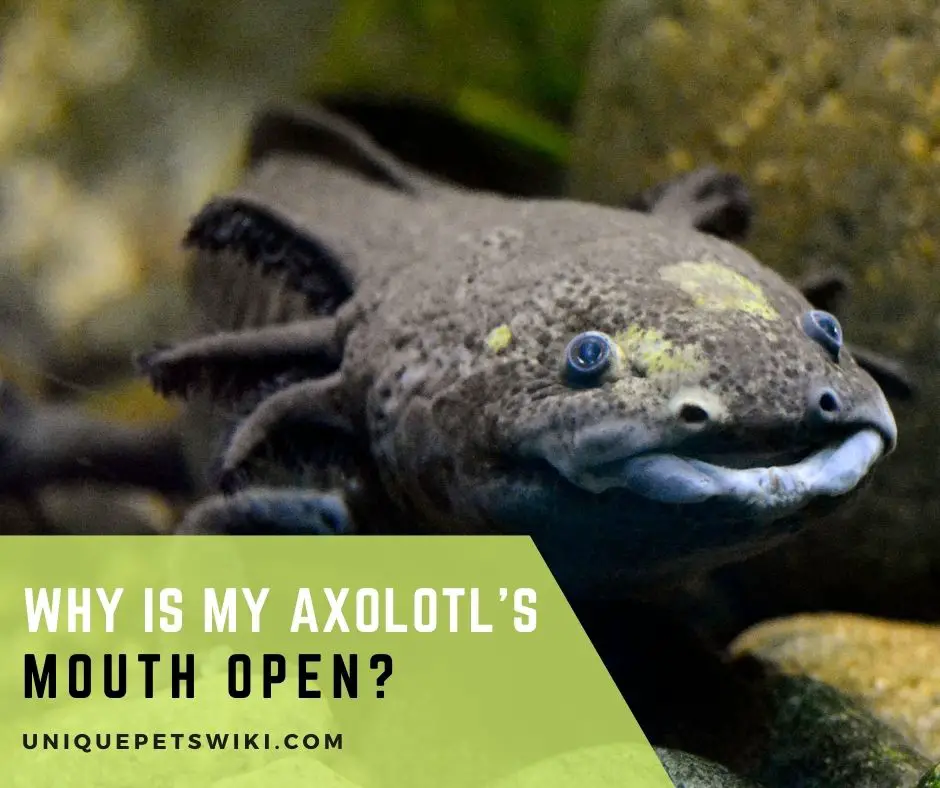As an axolotl owner, it is but natural to be concerned when your pet behaves abnormally. The slightest change from its routine behavior can cause immense stress in us Axie owners.
One such ‘abnormal’ behavior is that of an Axie keeping its mouth open. It might look as if it is gasping for air. Sometimes, it may even refuse food. All this can make any Axolotl parent very worried.
In this guide, we will discuss common reasons why an axolotl’s mouth open. Let us dive right into it.
This article has been reviewed by Dr. Gospel. Read more about our knowledge control process here.
Contents
Why Is My Axolotl’s Mouth Open?
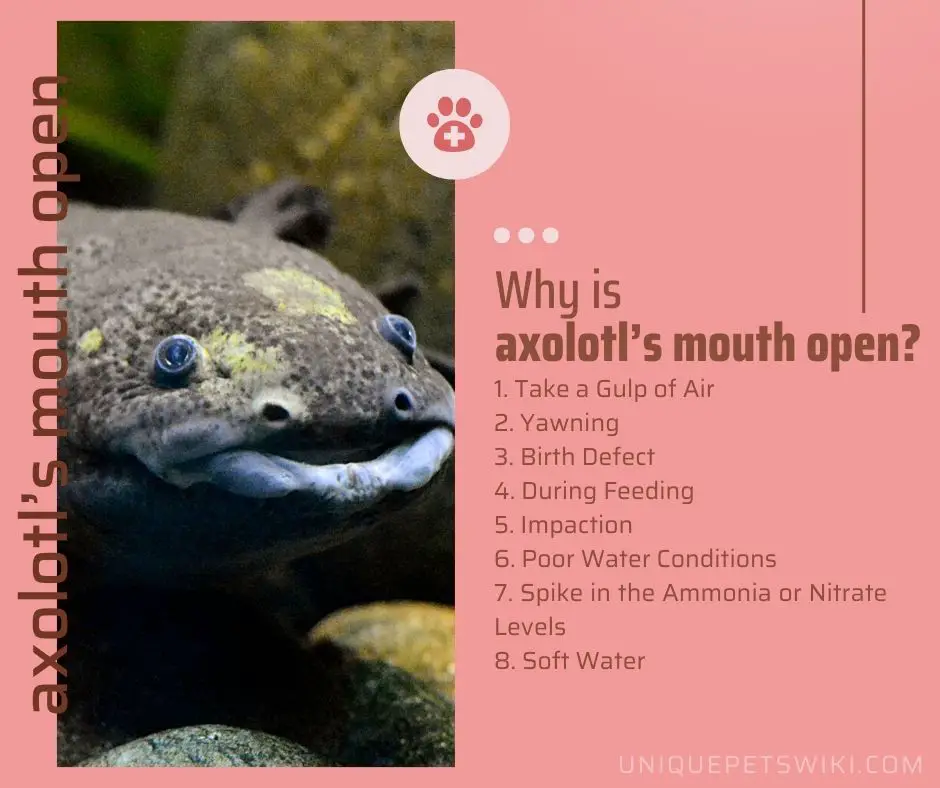
Axolotls often keep their mouths open for a variety of reasons. Sometimes, it is just normal behavior of taking in a big gulp of air – so you need not worry as long as your pet seems okay otherwise.
Sometimes, your axolotl might simply be yawning.
In rare cases, your Axie might be sick and have an issue such as food impaction or stuck food in its mouth or digestive tract.
Let us take a look at the detailed reasons as to why an axolotl keeps its mouth open.
1. Take a Gulp of Air
Axolotls come up to the surface of the water and open their mouths to take in a big gulp of air. Don’t worry this is normal behavior and they do it to keep afloat.
Of course, if your axolotl is constantly doing that, then it is indicative of poor water parameters. It may be that you need to change the tank water as there isn’t adequate oxygen in it.
Consider changing at least 75% of the water. If you forget to make weekly water changes, then it is best to add in a water filter, air stone, or bubbler in the tank.
Check out our detailed guide on Why Does My Axolotl Keep Going up for Air?
2. Yawning
Yawning is another fairly normal axolotl behavior and boy do axolotls look cute when they yawn!
Your pet might be lounging on the bottom of the tank and suddenly open its mouth wide – just like a human yawn.
Of course, Axies do not yawn because they are sleepy or tired; rather they yawn to release some of the excess gas or pressure after having overeaten. The yawning action might prevent them from throwing up.
Your pet should feel better after it has pooped but do continue to monitor it. If it keeps yawning, then have it checked by a vet.
Also read: Understanding Your Pet: 12 Common Axolotl Behaviors
3. Birth Defect
A birth defect could also result in your pet keeping its mouth open. This may be seen in very young axolotls.
Most axolotls have upturned mouths that seem like they are smiling. But rarely, a genetic issue could cause a young axolotl to be born with a gaping mouth.
You need not worry about this as long as your pet seems normal otherwise. Do check with an exotic vet or breeder who specializes in axolotls.
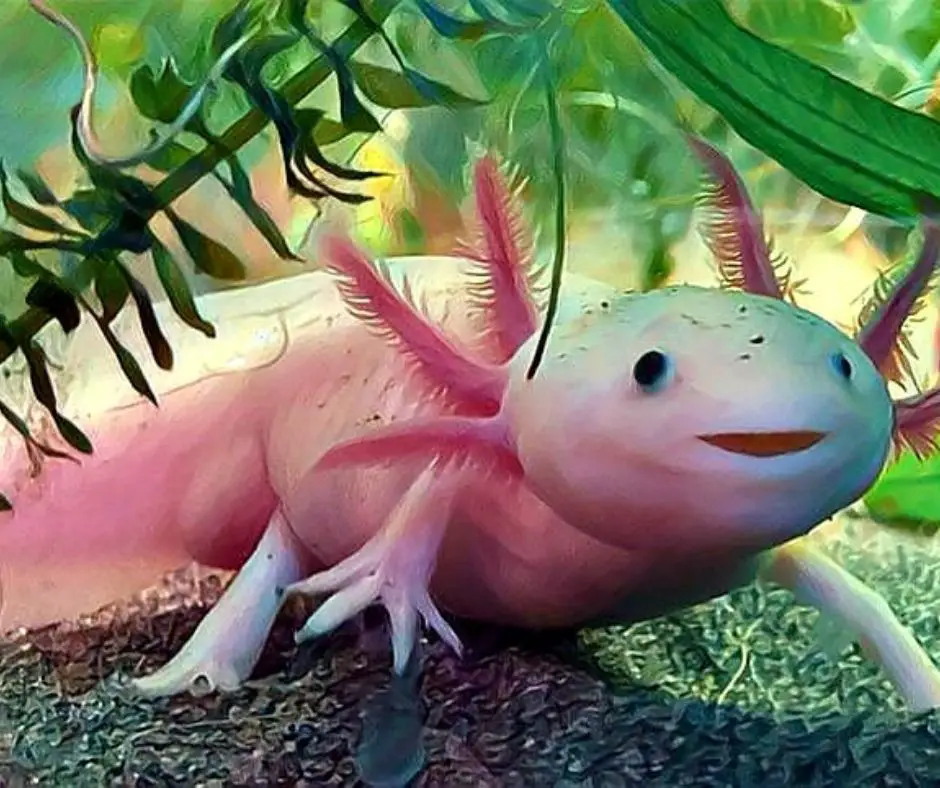
4. During Feeding
Axies are opportunistic predators. This means they “change their strategy” if they come across a prey they weren’t searching for in the first place.
Keeping their mouth open allows them to quickly swallow worms, shrimp, or other edible creatures in their vicinity.
It is important to feed your axolotl a nutritious diet. Bloodworms, earthworms, insects, small fish, and shrimp are good foods for Axies. You can also consider feeding readymade axolotl food pellets.
Also read: Axolotl Eating Worm: Complete Guide
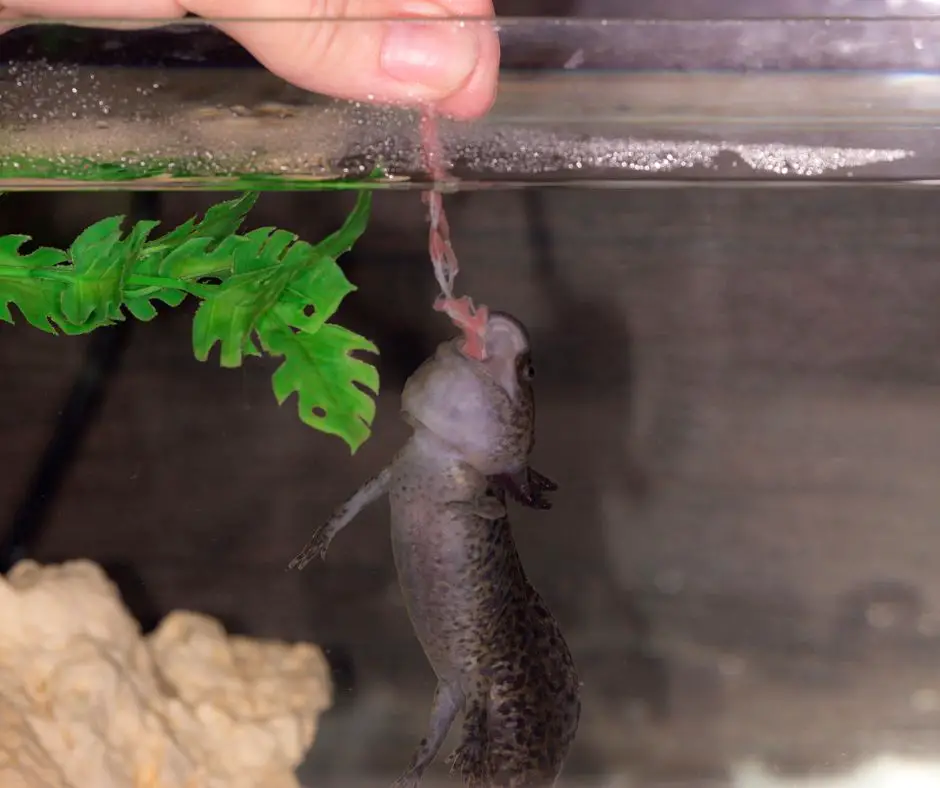
5. Impaction
If your axolotl keeps its mouth open for prolonged periods and is also refusing food for several days at a stretch, then chances are that it is impacted.
Impaction means that the food is not moving properly through its digestive tract.
Sometimes, the food may be stuck in its mouth or intestine. Sand impaction is another common issue. Most axolotls eat sand but usually, they are able to digest it well.
If you suspect your pet has eaten sand and is unable to poop afterward, then there is a chance of sand impaction. This is serious and your Axie won’t eat until it’s clear.
There are several things you can do if you suspect axolotl is impacted:
Fridging
- Fridging means refrigerating your axolotl. First, you transfer it to a container containing cool dechlorinated water and keep the container in the refrigerator.
- If you do not have a fridge for this purpose, you need to keep it in water having a temperature range of 41 to 44 F. Refrigeration is easier because you won’t have to worry about cooling the water and also the temperature won’t change too suddenly as that could shock your pet.
- You need to ‘fridge’ your axolotl for several days or at least until it poops.
- Fridging is completely safe and even if you do it for a few extra days, it should not hurt your little pet.
- Fridging lowers the axolotl’s body temperature so it won’t feed much during the period. Still, you could try offering some worms to see if it eats.
Surgery
If fridging does not yield results and your pet is still impacted or restless, then please see a vet.
Your axolotl will need surgery to remove the blockage. Not all vets are trained to perform such surgery, so look for exotic vets having these skills.
6. Poor Water Conditions
As explained earlier, optimum water parameters are very important for your axolotl’s well-being. Many factors can cause the water conditions to be deemed as poor.
According to the experts at the Royal Veterinary College, certain water conditions can cause stress and illness in axolotls:
- Poor cramped housing – Axies are solitary beings and they are best housed alone. A new tank mate can cause stress in your pet. The tank size should also be at least 20 gallons.
- Over filtration can also stress your axolotl. At the same time, ammonia levels in water are very dangerous and could kill them. So, if you use a water filter, make sure it has a light flow. If you do not use an air stone or filter, then change 10-30% of the water every week.
- Warm water can stress your little pet. They prefer cooler water and the temperature should be between 16-18 deg or 60-64 F.
- Chlorine is harmful to axolotls so only use de-chlorinated water.
- Harmful pH levels – the pH of axolotl tank water should be between 7.4-7.6.
- Improper substrate – these days, you get many types of substrates for aquariums. However, sand is the best choice. Avoid gravel since axolotls have a habit of eating it.
- Bright lights – these nocturnal creatures hate bright lights and even daylight or sunlight reflecting in the tank could stress your little pet. Place the tank in a cool, dark place. Avoid using bright lights for decoration. Also, provide your axolotl with plenty of hides, rocks, open pipes, and safe cave-like structures to rest during the day.
Check all of the above pointers and make necessary changes. If your pet continues to keep its mouth open, see a vet.
Also read: Full Requirements & Water Conditions for Axolotl in Captivity
API TEST KIT
- Contains one (1) API PH TEST KIT 250-Test Freshwater Aquarium Water pH Test Kit, including 1 bottle of testing solution, 1 color card and 1 glass test tube with cap
- Helps monitor and adjust pH and prevent invisible water problems that can be harmful to fish
- Accurately reads pH 6.0 - 7.6 and helps avoid fish loss
- Because different geographies have different tap water conditions, and different fish need different pH levels to be healthy, API helps measure pH levels and detect pH fluctuation caused by fish waste, uneaten food and addition of tap water.
- Use for weekly monitoring and when water or fish problems appear
Last update on 2022-12-28 / Affiliate links / Images from Amazon Product Advertising API
7. Spike in the Ammonia or Nitrate Levels
If your axolotl is keeping its mouth open, refusing food, or being inactive, then the water parameters could be off.
- Ammonia levels tend to spike due to the decay of natural matter in the tank. High levels of ammonia are very harmful to your axolotl.
- Purchase a water test kit and follow the instructions on it to measure the ammonia and nitrate levels in the aquarium water. The kits come with color charts which you compare your test results against. They give you an indication of how much nitrates or nitrite and ammonia there is in your tank.
- Axolotls can tolerate ammonia levels less than 2mg/l whereas nitrate levels should be less than 40 ppm. But zero ammonia and nitrite levels would be optimal. If your test kit shows levels above these values, make the necessary changes.
- Avoid using any products that claim to reduce ammonia or nitrite and nitrates in aquarium water as they could end up doing more harm than good.
- It is best to use a water filter to reduce nitrates and ammonia in the tank.
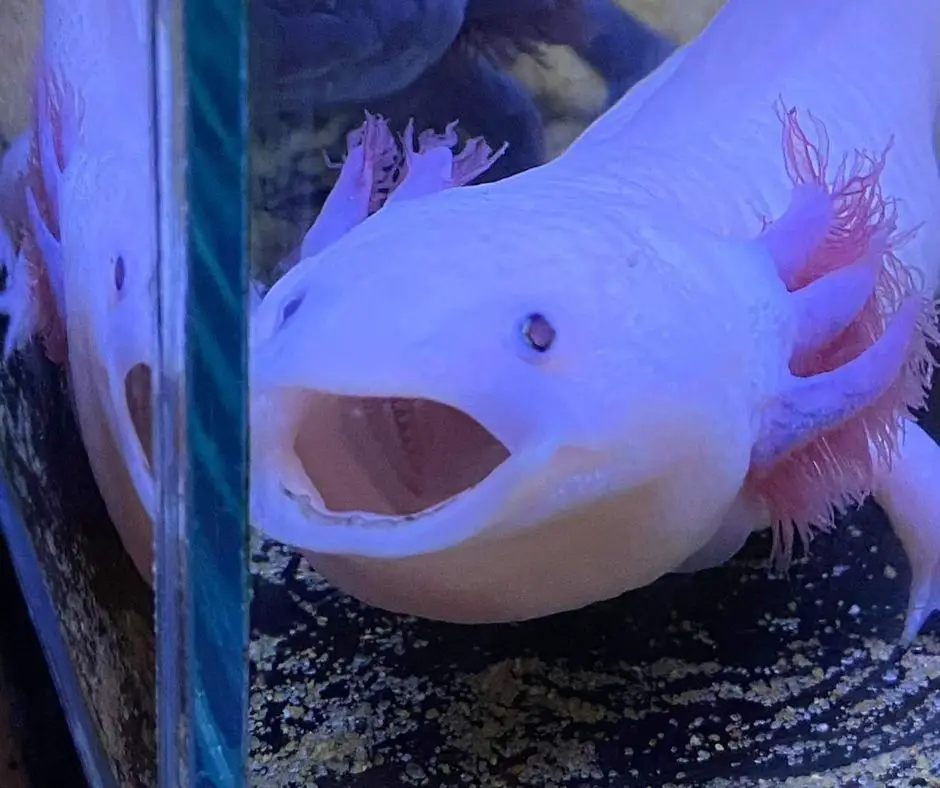
8. Soft Water
Soft water is acidic and too much acid can be harmful to your axolotl. Axolotls come from lakes in Mexico that are supplied by freshwater from springs and melted snowcaps.
That is why these freshwater creatures prefer slightly harder water or water dense with salts.
Soft water can lead to fungal issues and finrot in your little baby. Furthermore, it can also cause stress and anemia which can result in it keeping its mouth open to get in more oxygen.
The ideal water pH should be between 7.4-7.6. Keep pH strips handy to check your water from time to time. If the pH is too acidic, add some salts or make water changes to balance it.
Also read: Are Axolotls Saltwater?
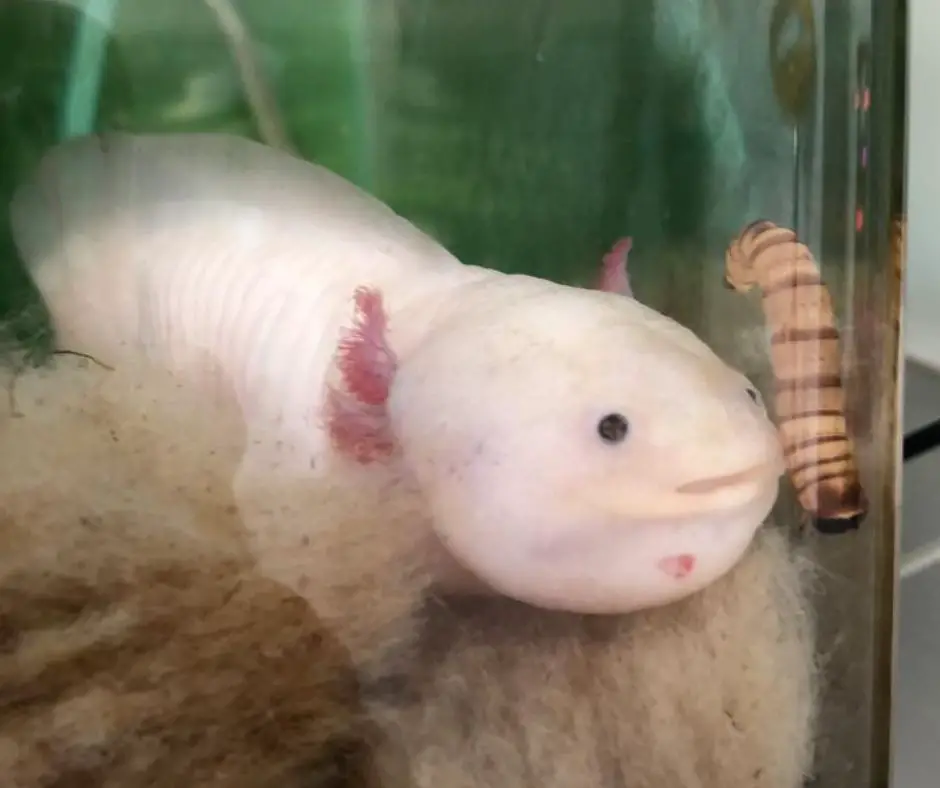
Signs Your Axolotl is Dead
Axolotl mouth open can also be a sign of death. Here are some other signs of a dead/dying axolotl:
- The axolotl’s gills will curve and its mouth will be wide open
- It will be pale in color
- It will have poor balance if it tries swimming
- It will refuse food entirely.
A dead axolotl will be very stiff and completely unresponsive to touch. Observe your axolotl for a few hours. If there is no movement at all, please call your vet.
Also read: 8 Axolotl Dying Signs (and Some Treatments)
2-in-1 Combo pH & Temperature Meter Water Quality Tester
- MEASURING RANGE: 0.00~14.00pH and 0~55°C (32~131°F) Temperature with ATC so temperature change can't affect on pH level measurement.
- APPLICATIONS: Great for student, professional and even personal used in achieving the correct pH and temperature level in water quality monitoring and analysis.
- FEATURES: Separate electrode to avoid contamination, composed of replaceable BNC type electrode and fixed temperature probe
- POWER SUPPLY: 4 x 1.5V AG13 button battery or 6V DC power adaptor ideal for continuous monitoring
Last update on 2022-12-29 / Affiliate links / Images from Amazon Product Advertising API
Conclusion
As seen above, many factors can cause an axolotl to keep its mouth open.
Sometimes, it is normal behavior done to get in more oxygen. In extreme cases, it may be more serious such as food or sand impaction.
In any case, it is best to observe your pet for a few days. If the behavior continues or worsens and home remedies such as fridging do not help, then please see your vet.
